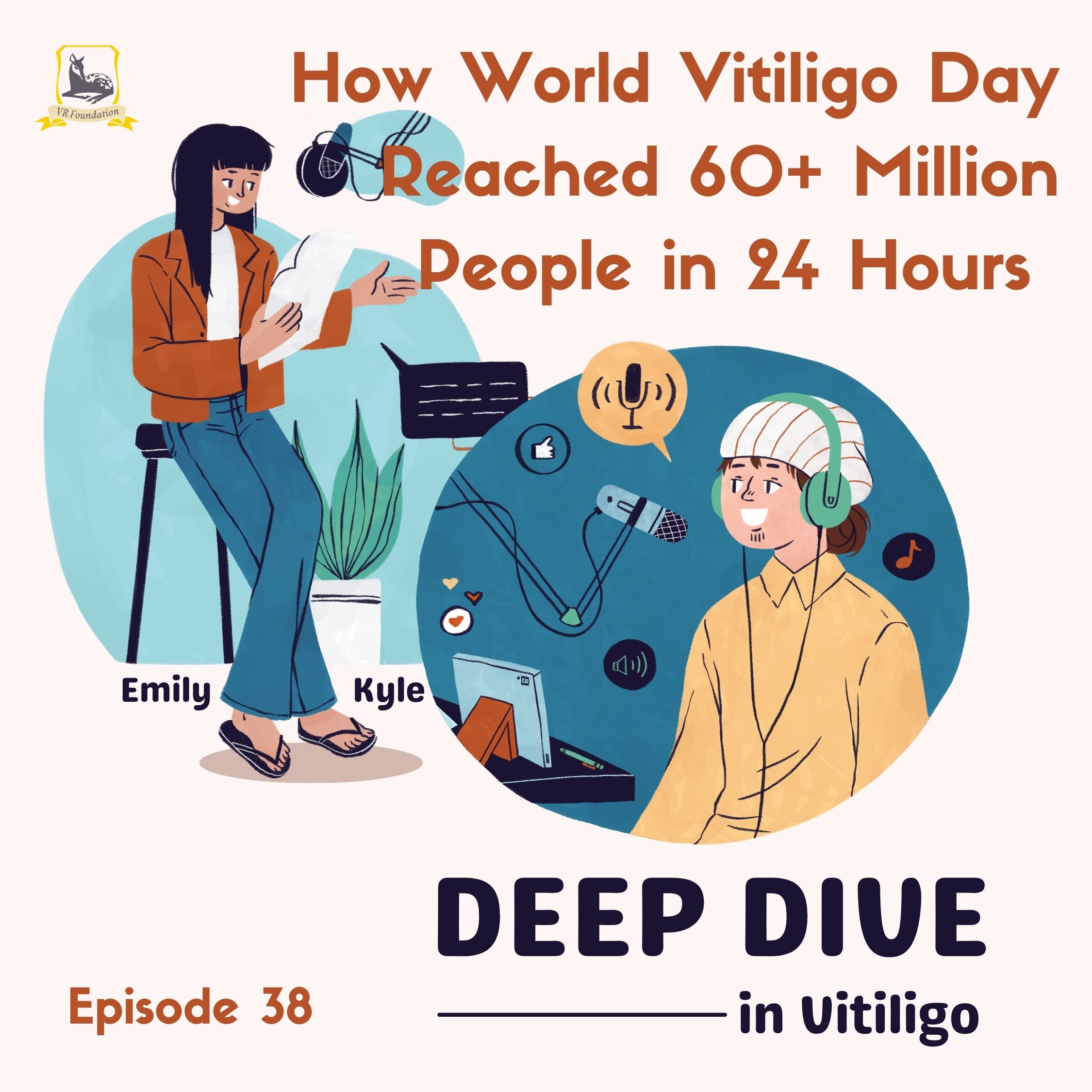Our work is entirely funded by private donations – we receive no money from government. Your money will help us continue funding research into vitiligo and supporting people affected by the condition.
Podcast
How World Vitiligo Day Reached 60+ Million People in 24 Hours (Ep. 38)
Fifteen years ago, vitiligo was a condition people barely whispered about. Today, World Vitiligo Day punches into nine-figure territory on social media and breakfast TV—without a Hollywood budget.
In this episode we trace WVD’s unlikely rise:
- The kitchen-table origins in India, Nigeria, and Rome
- A rolling-headquarters model that keeps the stage moving—and growing
- Toronto 2025’s data-driven media blitz that clocked 60 million unique viewers and crushed AI forecasts by 25×
- Why brands are lining up for a ride on the 2026 edition in Chandigarh
Whether you’re in healthcare, marketing, or grassroots activism, tune in for a masterclass on turning a patient whisper into a global roar—plus a sneak peek at what’s next.
Unpacking the Unprecedented Reach of a Patient-Powered Movement
A rocket that started as a kitchen-table sketch
Back in the late 2000s, vitiligo advocacy was a patchwork of small, local sparks. Dr. Savita Malhotra declared a National Vitiligo Day in India in 2009. Valarie Molyneaux rallied U.S. patients through support groups. Nigeria’s Ogo Maduewesi chose 25 June 2011—Michael Jackson’s memorial date—for her “Purple Fun Day,” proving a single idea could cut across continents and cultures.
The Vitiligo Research Foundation (VRF) saw those sparks and built a launch pad. In 2012, VRF’s Yan Valle and Prof. Torello Lotti unveiled the first truly international World Vitiligo Day (WVD) at Rome’s University of Guglielmo Marconi. Two big design choices set WVD apart:
- Rolling headquarters. A new host country every year—Italy, India, China, the U.S., and, in 2025, Canada—keeps the energy fresh and the message local.
- Bottom-up network. Instead of a costly central office, WVD empowers coalitions of doctors, artists, influencers, and patients who already know their own communities best.
The result is a grassroots rocket that has gained altitude every single year without burning through big-pharma-style budgets.
Toronto 2025: measuring the roar for the first time
Toronto 2025 finally put hard numbers behind the hype. On June 25, breakfast-TV spots on Global News Morning and CP24 reached roughly a quarter-million viewers once online replays were counted. TikTok was the runaway engine, generating more than 54 million hashtag impressions in just 24 hours. Instagram added another 12 million views through about 1,100 fresh posts, while Facebook’s event pages and livestreams contributed roughly 3 million. After de-duplicating overlaps, the campaign touched around 60 million genuinely distinct people that day, and the total impressions—once shares and reposts are factored in—ballooned to about 81 million, a figure that dwarfed the original AI forecast by a factor of twenty-five.
Why sponsors should take note
A single-day, nine-figure footprint—built largely on donated airtime and volunteer content—offers a rare mix of scale and efficiency. Brands looking to align with inclusive, tech-savvy health communities get:
- Multi-platform coverage that natively spans Gen Z (TikTok) to Boomers (Facebook).
- Authentic, patient-led storytelling that beats glossy ads for credibility.
- A clear data trail to demonstrate ROI—especially now that baseline metrics exist
The iceberg beneath the surface
Toronto’s numbers don’t yet include:
- Official campaign sites, newsletters, and linked click-throughs
- Winnie Harlow’s parallel media blitz
- LinkedIn, Telegram, X/Twitter, radio, podcasts, or print
- WVD-USA’s three-day event in Tampa (27–29 June)
- Europe-wide drives by VIPOC partners
When those pieces finish loading into the spreadsheet, analysts expect a 120–150 M global impression range—a figure once reserved for pop-culture juggernauts.
Five lessons for future health campaigns
- Local voices scale faster than global slogans. Give communities the mic and let hashtags travel.
- Rotate leadership. A new HQ each year injects fresh networks, media contacts, and cultural fluency.
- Data beats anecdotes. Even a lean analytics stack can prove value to sponsors and policymakers.
- Meet audiences where they already scroll. Traditional press coverage still matters, but TikTok and Instagram move the needle.
- Celebrate, then iterate. Each host city hands the baton forward, adding playbooks, contacts, and lessons learned.
The journey ahead
Next stop: Chandigarh, India, for WVD 2026—a full-circle return to the birthplace of India’s first national vitiligo day back in 2009. Whether you’re a potential sponsor, clinician, patient advocate, or simply someone who loves a good underdog story, the rocket has room for more passengers.
Ready to help it climb even higher? Visit worldvitiligoday.org or drop VRF a line—because the roar is only getting louder.
Published on July 1st, 2025

FAQOther Questions
- Shall I take vitamin D for my vitiligo?
Vitamin D plays a central role in the prevention of different inflammatory and chronic diseases. Consuming 1,000–4,000 IU (25–100 mcg) of vitamin D3 daily should be ideal for mo...
- Can a gluten-free diet help with vitiligo?
It's very unlikely. We have specifically looked into claims that gluten-free diet may ease symptoms of vitiligo, or completely reverse it, and found no firm scientific evidence ...
- Is it possible to stop the progression of vitiligo?
While it's not always possible to quickly stop vitiligo progression, there are some treatments that can help slow or halt the spread of the condition in many cases: Corticoster...
Though it is not always easy to treat vitiligo, there is much to be gained by clearly understanding the diagnosis, the future implications, treatment options and their outcomes.
Many people deal with vitiligo while remaining in the public eye, maintaining a positive outlook, and having a successful career.
Copyright (C) Bodolóczki JúliaBy taking a little time to fill in the anonymous questionnaire, you can help researchers better understand and fight vitiligo.